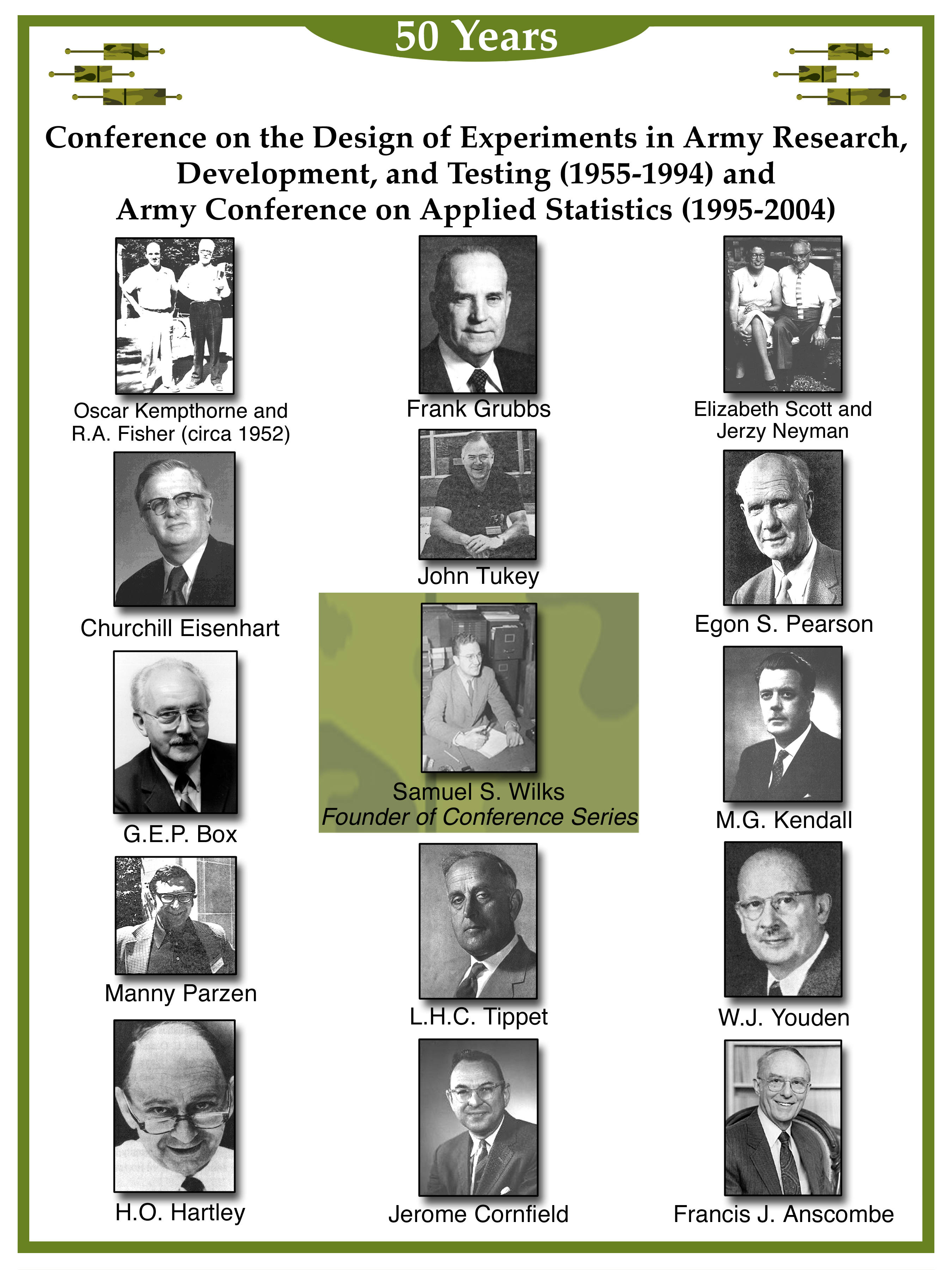62 Years of the Conference on the Design of Experiments in Army Research, Development, and Testing
(1955-1994)
Army Conference on Applied Statistics
(1995-2012)
Interface Conference on Applied Statistics (2013)
Conference on Applied Statistics in Defense (2014-2016)
The Conference on Applied Statistics in Defense (CASD) was the successor to the Conference on the Design of Experiments in Army Research, Development, and Testing. Professor Samuel S. Wilks, of Princeton University, proposed the formation of a conference focusing on the design of experiments in Army research, development, and testing after a survey by the Army Mathematics Steering Committee found that Army scientists in over 30 Army facilities perceived a need in this area. Wilks, a member of that committee, proposed the idea to COL Leslie E. Simon (later to become Major General), who was Assistant Chief of Ordnance for Research and Development, U.S. Army, and a personal friend of Wilks.
Months later, on 19-21 October, 1955, the first conference was held at the Diamond Ordnance Fuze Laboratories (now part of the U.S. Army Research Laboratory) and the National Bureau of Standards (now the National Institute for Standards and Technology) with organizational responsibility falling to the Office of Ordnance Research (now the U.S. Army Research Office). Wilks chaired the conference each year until his death in 1964. The conference formally concluded in 1994.
CASD, originally the Army Conference on Applied Statistics (ACAS), was established in 1995 by six sponsoring activities within the national defense community: the U.S. Army Research Laboratory, the U.S. Army Research Office, the U.S. Military Academy, the Walter Reed Army Institute of Research, the National Institute of Standards and Technology, and TRADOC Analysis Center-White Sands Missile Range. In the ensuing years, the organization broadened its mission to include context areas of national importance and has attracted more industry, academia, and other government agencies. In 2013, CASD was established to reflect the broadening role. The present direction represents a natural progression from being a conference under Army direction (1995-2004) to one under the direction of the Interface (2005-2012) to one that continues under the Interface but with an expanded role in the statistical community (2013-2016).
CASD continued the traditions of the Design of Experiments Conference, while broadening the statistical scope with a more aggressive pursuit of emerging methodologies and expanding the application area to all military services and generally to all defense and security issues. Today’s services face challenges that are far ranging and encompass many topics, in addition to experimental design, in which probability and statistics have a contribution to make.
CASD was a forum for the presentation and discussion of theoretical and applied papers related to the use of probability and statistics in solving problems of national importance. The conference provided an invaluable opportunity for interaction among academic, industry, and government scientists. It also served a nurturing role in the elevation of statistical competence among researchers in other disciplines who found themselves statistical practitioners because of the compelling benefits statistical science brings to research, development, and testing.
CASD was structured as follows. General sessions offered invited presentations on emerging topics in statistics. Special sessions focused attention on national problem areas in which the role of statistical science could be more fully explored. Contributed sessions included papers ranging from new methodology to interesting statistical application. In the clinical sessions, a distinct feature of the conference, presenters could seek guidance from a panel of experts for problems that have not been completely or satisfactorily solved.
Two other important events took place at the conference. A tutorial on a statistical topic believed to be important in national application precedes each conference. The Army Wilks Memorial Award was given periodically at this conference to an individual who has made substantive contributions in the area of national defense to commemorate the service of Sam Wilks.
The conference chair, program chairmen, and proceedings editors are summarized here. Beyond, that there were many other people who did much work or assumed responsibility in some way for the conference.
| Conference Chair | Program Chair | Proceedings Editor |
|---|---|---|
| Samuel S. Wilks, 1955-1963 | Samuel S. Wilks, 1955-1956 | Francis G. Dressel, 1955-1993 |
| Frank Grubbs, 1964–1974 | Frank Grubbs, 1957–1980 | |
| Herbert Solomon, 1975–1977 | ||
| Douglas B. Tang, 1978–1990 | Douglas B. Tang, 1978–1990 | |
| Barry A. Bodt, 1991–2012 | Barry A. Bodt, 1991–2012 | Barry A. Bodt, 1995–2003 |
| Edward J. Wegman, 2000–2002 | ||
| Yasmin Said, 2003-2004 | ||
| Wendy Martinez, 2013 | ||
| Wendy Martinez and Edward Wegman, 2014 | ||
| Edward Wegman, 2015 | Proceedings for 2015 and 2016 are published as part of the Joint Statistical Meetings Proceedings sponsored by the Section on Statistics in Defense and National Security | |
| Alyson Wilson, 2016 |
